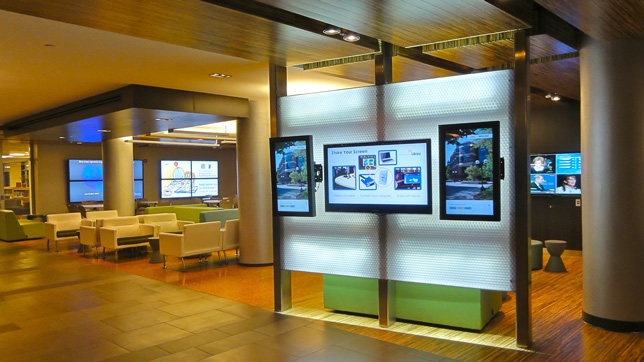Why Higher Ed Is Poised to Lead the Way in Digital Signage
Colleges and universities have not always been known for innovation in AV technologies, but advances in digital signage are putting higher education at the forefront of the field.

Courtesy of the University of Michigan
Let me begin with a bit of candor. Over the years, I have observed that when those in the AV integration industry speak about typical projects for the education market, they usually sound mundane and it is easy to assume what the project will entail. Since the turn of the century, most AV designs have embraced a standard cookie cutter approach, with simply a projector (with a screen) or a flat panel display setup in the classroom. For the more advanced designs, perhaps a sound system and remote control of some sort.
Until recently, the status quo meant that little creativity was inspired in education AV, and certainly few instances of pushing the technological envelope. For those out there who have more advanced systems, save the e-mails: I do know there are some examples of creativity and pushing the envelope, but most classrooms are just basic AV at the core. Rarely less, but rarely more.
There are a lot of reasons for this. First and foremost, there are budgets to consider. Education has always been budget conscious with variations in funding region by region, school by school and department by department. The largest portion of funding tends to go to the most visible (read: profitable) departments and the more obscure ones tend to languish money-wise.
A second issue is a lagging knowledge and acceptance of more advanced AV technologies in many schools. Again, this varies by department, but university technicians (a.k.a. the people who make the systems work) tell me that many professors are reluctant to learn how to use the systems, and have concerns that the systems are unreliable and will impede their teaching effectiveness. The fact is that whether we are speaking about budgets, total cost of ownership or learning curves (and acceptance) by the teaching community, education has not been a bastion of AV technological advancement until recently.
Of course this begs the question, what has changed? The answer lies within two concepts: the ubiquity of networks and digital signage. These two elements have altered the way things are done on many university campuses, and the combination involves a rapid expansion far beyond the confines of a projector or flat panel display in the student union that might have been a typical example a few short years ago.
Conventional wisdom tells us that educational institutions should be a driving force of innovative ideas and applications, but the hallowed halls of academia have not always lived up to that ideal — at least in the case of AV technologies and advanced communications. The good news is that colleges and universities are now beginning to exceed previous expectations. In fact, the world of education is becoming the incubator of AV technologies and digital signage applications, design and acceptance in the market. Advances in digital signage are permeating other market niches as well, such as corporate and healthcare, with education rightfully leading the way. Bold claims aside, let's examine some specifics on how this has become a reality.
As an umbrella to all of this, we need to consider the impact that instant information and connectivity have had on all our lives, and how it has radically changed how we think and act over the last few years. As a population, we have changed the way we send and receive information in every way — from our TV viewing habits at home, all the way to business and yes, education. We are not only acclimated but in many cases addicted to our smartphones, tablets, laptops and even smartwatches with e-mails, text messages and tweets. We don't write personal letters anymore, we communicate via Facebook or Twitter and connect professionally via LinkedIn. People are expecting and demanding that information come to them immediately where they are and not vice versa. This is the genesis of the new wave and expanded view of communication and uses of digital signage.